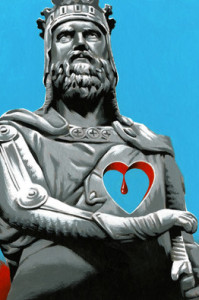Halloween is an eloquent denial of the finality of death. Throughout history, people have resisted the idea that life begins and ends with the human body. Even the most ghoulish Halloween story starts with the premise that life exists in more than one realm.
During the medieval period, the belief that the physical and spiritual worlds were intertwined fed into the idea that the soul was located inside the heart. Many aristocrats and royals even had their hearts removed after death. Their corpses were then interred in the family crypt, while the heart was preserved and buried in a place of spiritual significance.
That usually meant a favorite monastery. But for Richard I, known as “The Lionheart” (he supposedly once ate the heart of a lion), it meant having his body buried in England and his heart in France—a way to demonstrate his divine right to wear the crowns of both kingdoms.
Jerusalem was another popular destination. This was where Robert the Bruce (1274-1329), king of the Scots, begged his fellow knights to bury his heart. A band of Celtic crusaders duly set off, bearing the organ inside a silver casket. They got as far as Spain, where most of them were killed fighting the Moors. The heart was rescued by one of the survivors and carried back to Scotland. It was subsequently lost until the 20th century, when archaeologists accidentally stumbled upon the casket while making an inventory of Melrose Abbey in Roxburghshire, Scotland. The heart was left in situ, denying Robert his wish.






